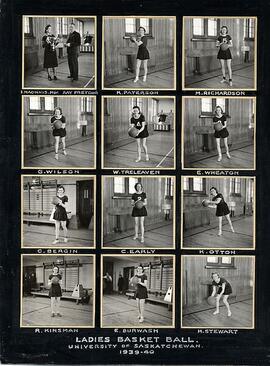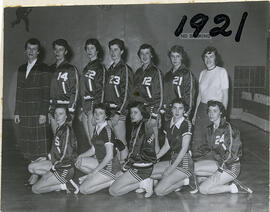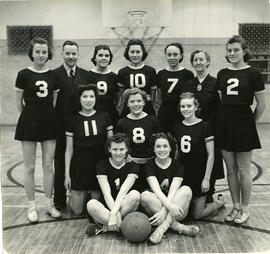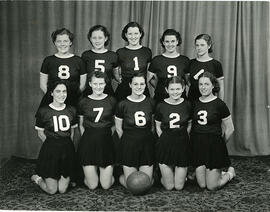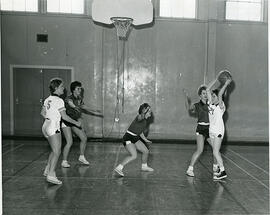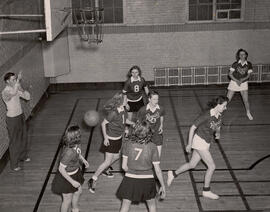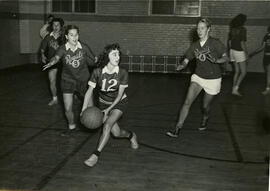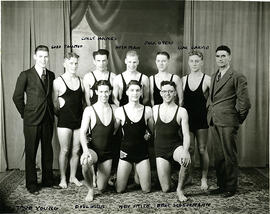Posed indoor image of sports coaches: Ches Anderson, wrestling; Lyn Bannister, hockey; Don Bailey, curling; Don Burgess, athletic director; Malcolm Cant, swimming; Don Fry, basketball; Cedric Gillott, soccer; Reg Haskins, fencing; Bob Laycoe, assistant athletic director, assistant football and wrestling coach; Al Ledingham, football; Doris Miller, diving; Barry Mooney, assistant football coach.; Warren McKay, fencing; Wayne Perkins, assistant football coach; Lyle Sanderson, cross country, indoor track and field; Chuck Sebestyen, gymnastics; Tony Schildo, diving; Paul Schoenhals, assistant football coach.
Bio/Historical Note: Dr. Doris I. Miller earned a Bachelor of Physical and Health Education from the University of Toronto (1961), an MA from University of Oregon (1964) and was the first PhD graduate (1970) from Penn State University’s new biomechanics program. She later earned a Master’s in Divinity from University of Victoria (1990). Dr. Miller's sport biomechanics research spanned four decades investigating a variety of sports, but her true passion focused on diving biomechanics. Dr. Miller is considered a world leader in diving research and was a pioneer in bridging the gap between scientific research and coaching. In her PhD thesis, Dr. Miller developed a 3D multisegmented dynamic model to investigate flight characteristics of diving performance which required a computer mainframe program that used over 3,000 punch cards to create (Wikipedia link to what punch cardcomputing is https://en.wikipedia.org/wiki/Punched_card). Dr. Miller was a diving coach at the University of Saskatchewan before becoming a faculty member at University of Washington and later University of Western Ontario (now Western University). From 1983-2009 Dr. Miller was a Performance Enhancement Team member for USA Diving and a biomechanist for the Olympic Medal Program. She collected data live at the Fifth World Aquatics Championships in Madrid (1986) and at the Olympic Games in Atlanta (1996) among a host of other international diving competitions. In Madrid and Atlanta, the 10-m diving tower was instrumented with a force plate to capture data live on all competitive dives. During that time, she also worked with Canada’s high-performance divers. As a result, Dr. Miller created an extensive database of all the international divers that she used to create coaching software that permitted the comparison of any diver’s biomechanical data to those of Internationally ranked competitors. This broke the barrier between sport biomechanics research and coaching. Dr. Miller was a founding member of the International Society of Biomechanics, the American Biomechanics Society and the Canadian Society of Biomechanics. She was the sixth president of the American Society of Biomechanics (1984). Dr. Miller was recognized in 2009 by the American Society of Biomechanics with the Jim Hay Memorial Award for Research in Sports Biomechanics. She is a Canadian Society of Biomechanics Career Award recipient and is a Fellow of both the Canadian Society of Biomechanics and the International Sports Biomechanics Society.She is an Honourary Member of the International Society of Biomechanics (2024)..

